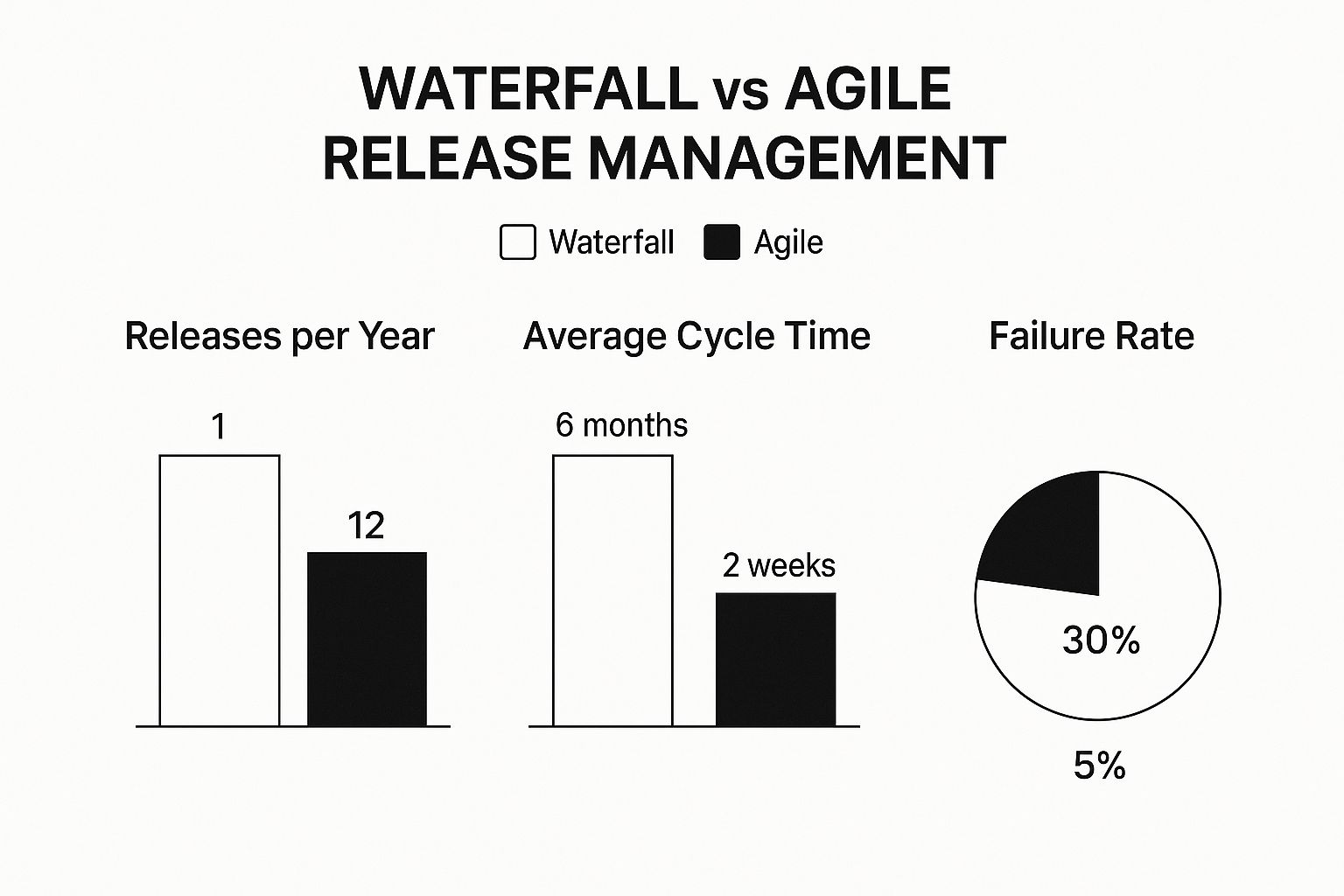agile release management
software delivery
DevOps practices
release planning
continuous deployment
Agile Release Management: Your Complete Guide to Success
Understanding What Makes Agile Release Management Work

Picture this: a software release gone wrong. The frantic scrambling, the blame game, the all-nighters spent patching things up. It’s a scene that plays out too often in development teams. But there’s a better way: agile release management.
Instead of a chaotic free-for-all, releases become a coordinated effort, like a well-rehearsed band hitting every note. It's not just about shipping code faster; it's about delivering valuable features consistently and keeping your team happy and productive.
Collaboration Is Key
Agile release management reimagines the traditional, often isolated, software development process. Rather than tossing finished work "over the wall" to the next team, it builds a collaborative environment where developers, testers, and operations folks work together in harmony.
Imagine a team building a new feature. In a traditional setup, developers might finish coding and hand it off to testing with minimal interaction. With agile release management, testers are involved right from the design phase, giving continuous feedback and ensuring the feature is easily testable from the get-go.
Catching Bugs Early
This collaborative approach drastically reduces the chance of nasty surprises late in the game. By integrating testing and feedback throughout development, problems are identified and squashed early, preventing small issues from becoming giant headaches.
Fixing bugs later is far more expensive and time-consuming than catching them early. Plus, this constant communication fosters a culture of shared learning and continuous improvement within the team.
The Rise of Agile
This shift toward collaboration has propelled agile methodologies into the mainstream. In fact, by early 2018, a whopping 91% of survey respondents reported their organization had adopted some form of agile development. This widespread adoption highlights the flexibility and responsiveness of agile, allowing teams to adapt quickly to changing requirements. Discover more insights into agile adoption.
Embracing the Change
The move to agile release management isn't always smooth sailing. Teams used to traditional workflows might resist the change at first. But the rewards – faster releases, higher quality software, and a happier team – usually outweigh the initial growing pains.
For another perspective on effective management practices, check out this article on incident management: Understanding What Makes Incident Management Actually Work. In the end, adopting agile release management empowers teams to build better software and create a more sustainable and fulfilling work environment. And that translates to a better, more reliable product for your users.
The Five Core Principles That Actually Matter

The infographic above gives us a quick snapshot comparing traditional Waterfall and Agile release management. It looks at releases per year, average cycle time, and failure rate. Notice how Agile shines with more frequent releases, shorter cycles, and a much lower failure rate. This really highlights Agile's strength: adapting to change and delivering value quickly and reliably. Let’s explore the five principles behind this.
Small, Testable Increments: The Building Blocks of Success
Imagine building a house. You wouldn't pour the foundation, build the entire frame, and then wire everything before checking if it's level, would you? Of course not! Agile release management takes the same approach with software.
Building in small, testable increments lets you verify each component works before things get too complex. This helps avoid finding major issues late in the game, saving you time and headaches.
Feedback Loops: Catching Problems Early
Think of a chef tasting their dish as they cook. They're not waiting until the end to realize it needs more salt. Agile release management emphasizes continuous feedback loops.
This means integrating testing and feedback throughout development, not just at the finish line. This allows for quick adjustments and keeps small problems from becoming big disasters.
Cross-Functional Collaboration: Breaking Down Silos
Traditional development sometimes struggles with siloed teams – developers, testers, and operations working in isolation. To understand how other teams have improved this, you can explore their approach to agile development documentation. Agile release management, however, promotes genuine cross-functional collaboration.
This means teams work together constantly, sharing knowledge, and making sure everyone is on the same page about goals and priorities.
Frequent Releases: Reducing Risk and Delivering Value
Instead of one huge, risky release, agile release management favors frequent, smaller releases. This minimizes the risk of each release. If something goes wrong, the impact is contained and easier to fix.
Plus, frequent releases provide ongoing value to customers, keeping them engaged and offering valuable feedback opportunities.
Customer Value: The Guiding North Star
In agile release management, customer value drives every decision. It's about constantly asking, "Does this feature truly benefit the customer?"
Prioritizing customer needs and feedback ensures you're building software that solves real problems and delivers real value. This customer-centric approach is key for long-term success.
To better illustrate the core differences between traditional and agile approaches, let's examine the following comparison:
| Aspect | Traditional Approach | Agile Approach | Business Impact |
|---|---|---|---|
| Planning | Long, detailed upfront planning | Incremental planning, adapting to change | Increased flexibility, faster response to market needs |
| Execution | Sequential phases, limited flexibility | Iterative development, continuous integration and delivery | Reduced development time, faster time to market |
| Risk Management | Risks addressed late in the cycle | Continuous risk assessment and mitigation | Early problem detection, minimized impact of failures |
| Team Collaboration | Siloed teams, limited communication | Cross-functional teams, close collaboration | Improved communication, shared understanding of goals |
| Feedback | Gathered primarily at the end | Continuous feedback loops throughout the cycle | Increased customer satisfaction, products that meet user needs |
| Release Frequency | Infrequent, large releases | Frequent, smaller releases | Faster delivery of value, reduced risk per release |
This table summarizes the key distinctions and how they translate to tangible business benefits. The shift towards agility brings about greater flexibility, faster delivery, and a stronger focus on customer value.
Building Your Team For Agile Release Success

Imagine a jazz quartet. Each musician brings their unique talent and instrument, creating magic when they improvise together. An agile release management team works much the same way. Individual roles blend together, creating a high-performing unit. Let’s meet the key players.
The Orchestrator: Release Manager
The Release Manager is like the conductor of an orchestra. They orchestrate the entire release workflow, ensuring smooth transitions between each stage. They aren't micromanaging, but rather facilitating communication and clearing any roadblocks. Think of them as the central hub for release status updates, keeping everyone in sync.
The Visionary: Product Owner
The Product Owner is the voice of the customer. They translate business needs into actionable user stories and features for the development team. By prioritizing what gets built and when, they ensure the team focuses on delivering maximum value. They're the ones making sure the music resonates with the audience.
The Facilitator: Scrum Master
The Scrum Master is the team's coach and protector. They focus on process improvement and removing any obstacles that slow the team's progress. They empower the team to self-organize and adhere to the core principles of agile. They're the ones ensuring the band plays in harmony.
The Builders: Development Team
The Development Team are the musicians who bring the product to life. They're the ones building and testing high-quality code, collaborating closely with testers and other team members to deliver a polished product. They’re the ones playing the instruments, bringing the music to life.
The Automator: DevOps Engineer
DevOps Engineers focus on automation, streamlining repetitive tasks within the release pipeline. This allows the rest of the team to focus on higher-level problem-solving and building valuable features. They're the ones ensuring the instruments are tuned and ready to play.
Avoiding Coordination Nightmares
Clearly defined roles are essential. But what happens when responsibilities overlap? This can lead to confusion and inefficiency, especially as agile principles extend beyond traditional IT functions. A 2019 KPMG survey found that 1 in 6 organizations reported using agile outside of IT—in areas like marketing and sales—even if they weren't using it for IT. This highlights just how widely applicable agile values are. Discover more insights into agile adoption.
Open communication is key to addressing role overlap. Clearly documented responsibilities for each role prevent misunderstandings. Regularly reviewing these roles, especially as the team and product evolve, is critical for long-term success. This proactive approach ensures everyone knows their part and minimizes potential conflict, making your agile release process more efficient and effective. Like our jazz quartet creating beautiful music, teams with clear roles and addressed overlaps establish a harmonious workflow.
Creating Your Release Workflow That Actually Works
Creating a solid agile release management workflow is a bit like designing a city's traffic flow. You need well-defined routes, detours for those inevitable fender benders, and systems to handle both the daily commute and rush hour madness. This careful orchestration is the key to keeping things moving smoothly. This section will walk you through building a workflow that actually delivers, from planning sessions that yield concrete decisions (not just endless meetings) to deployment pipelines that minimize those late-night fire drills.
Release Planning: From Meetings to Decisions
Effective agile release management begins with thorough planning. Think of this as laying the groundwork for a building – crucial for stability and avoiding headaches down the road. The release planning process should give you a clear roadmap. This roadmap should outline the project’s scope, timeline, and major milestones. It keeps everyone on the same page, focused on delivering real value. A good plan prevents confusion and rework, saving you precious time and resources. This sets the stage for smooth and predictable releases.
The screenshot above showcases project planning tools common in agile development. Note how tasks, timelines, and dependencies are visually represented. This makes it easy to track progress and spot potential roadblocks. These visualizations are incredibly useful for keeping everyone informed and aligned on the project's status and goals.
Sprint Integration: Maintaining Quality Under Pressure
Agile release management hinges on how well sprints are integrated into the overall release cycle. Every sprint should contribute to the final release, ensuring a continuous flow of valuable features. Think of sprints like individual bricks in a wall—each carefully placed and inspected to guarantee a solid structure. By prioritizing quality within each sprint, you guarantee a high-quality final product. This consistent focus also allows you to catch bugs early, reducing the chance of major problems cropping up later.
Deployment Pipelines: Reducing Emergency Calls
Deployment pipelines are the expressways of your release workflow. They ensure efficient and reliable delivery of your software. Automation plays a crucial role here. By automating repetitive tasks like testing and deployments, you not only minimize human error but also free your team to tackle more strategic work. Automated deployments lead to consistency, reducing the risk of unpleasant surprises and those dreaded 2 AM calls. This predictability boosts confidence in your release process and contributes to a more stable, dependable product.
Managing Dependencies and Hotfixes
Software development is complex, and features often rely on each other. Managing these dependencies is essential to prevent bottlenecks and maintain momentum. Imagine a team stuck waiting for another team to finish a critical piece before they can continue—this can seriously delay the entire release. Effective agile release management tackles these dependencies head-on, allowing teams to work concurrently as much as possible. Equally important is a well-defined process for handling those urgent hotfixes. This lets you quickly address critical issues without derailing your release schedule. A solid hotfix process minimizes disruption and keeps your users happy.
Maintaining Visibility and Stakeholder Communication
Transparency is paramount in agile release management. Keeping stakeholders updated on progress without endless status meetings can be tricky. This is where clear communication channels and accessible dashboards make a real difference. Using project management tools like Atlassian Jira to track progress and share updates reduces the need for constant meetings and keeps everyone informed. This shared visibility fosters trust and lets stakeholders focus on the bigger picture without getting lost in the day-to-day minutiae.
By adopting these strategies, your agile release management process will go from a potential source of stress to a reliable engine for delivering value to your customers. This not only improves your product but also boosts your team’s productivity and morale. These practices are the bedrock of a sustainable and thriving software development operation.
Scaling Agile Practices for Your Organization Size

Agile release management isn't a one-size-fits-all solution. Just like choosing the right clothing, a small startup needs a different approach than a large enterprise. A small team needs something lightweight and flexible, while a larger organization needs something more structured and tailored. Let's explore how to adapt agile release management to different organizational structures.
Small Teams: Keeping It Simple
For small teams, speed and simplicity are king. Think of a small band – they can easily coordinate and change their music on the fly. Heavy processes and tons of documentation would just slow them down.
Instead, focus on the core agile principles: frequent communication, short feedback loops, and iterative development. Simple tools like Trello or even a shared spreadsheet can be enough to manage releases effectively. The key is to avoid unnecessary overhead and keep the focus on building and shipping quickly.
Mid-Sized Companies: Adding Structure Without Stifling Agility
As companies grow, the need for more structure emerges. Imagine a growing orchestra – they need a conductor to keep everyone in sync. Mid-sized companies benefit from introducing more formal release management processes, such as defined roles and workflows.
Automating tasks within your release workflow is a great way to ensure consistency and reduce errors as the team expands and projects become more complex. Check out some Jira workflow automation strategies for inspiration. Tools like Jira or Asana can provide structure without sacrificing the collaborative spirit of agile.
Large Enterprises: Scaling Agile Across the Organization
Scaling agile release management in a large enterprise is like coordinating a global event – it requires careful planning and robust systems. Standardized processes, clear communication channels, and sophisticated tooling become essential for success.
Consider a hybrid approach, combining agile practices with more traditional methodologies. This helps accommodate different team needs and any regulatory requirements. This is becoming increasingly common. For example, in 2023, while 71% of companies used agile, 49% of larger organizations used a mix of agile, DevOps, or other frameworks. Explore agile adoption trends. Tools like Azure DevOps or GitLab can help manage the complexity of releases across multiple teams and time zones.
Finding the Right Balance With a Hybrid Approach
Many organizations find that a hybrid approach works best. This means blending elements of agile, DevOps, and even traditional waterfall methodologies. The key is to find the right mix for your specific situation, organizational culture, and project needs.
This lets you leverage the strengths of each approach while mitigating their weaknesses. For example, you might use agile for developing new features but a more structured approach for critical system updates.
To help illustrate the different tools and practices that work well for varying organization sizes, take a look at the table below:
Agile Release Management Tools by Organization Size Recommended tools and practices for implementing agile release management across different organization sizes, from startups to enterprises.
| Organization Size | Recommended Tools | Key Practices | Common Challenges |
|---|---|---|---|
| Startup | Trello, Shared Spreadsheets | Frequent communication, short feedback loops, iterative development | Maintaining focus, lack of documentation |
| Mid-Sized Company | Jira, Asana | Defined roles and workflows, automated tasks | Balancing structure and agility |
| Enterprise | Azure DevOps, GitLab | Standardized processes, clear communication channels, hybrid approach | Scaling agile across teams, managing dependencies |
As you can see, the complexity of tools and processes increases with the size of the organization. Startups benefit from simplicity, while enterprises require more robust solutions to manage scale and complexity.
By carefully considering your organization's size and context, you can tailor your agile release management practices for maximum effectiveness. This adaptability is key to achieving the core benefits of agile: faster time to market, higher quality software, and a more responsive development process. Remember, the goal isn't to rigidly follow a methodology but to build a system that empowers your teams to deliver value efficiently and consistently.
Choosing Tools That Support Your Team Instead of Owning It
The right tools can make all the difference in agile release management, turning a chaotic process into a smooth, predictable one. But the "best" tool isn't the one packed with the most features. It's the one your team actually uses. Think of it like a chef's knife: a high-end blade is worthless if it's too cumbersome to handle. This section explores the key tool categories you need, focusing on how successful teams weave them into their daily work.
Essential Tool Categories
-
Version Control Systems: These are your safety net, letting you track changes, rewind to earlier versions, and collaborate on code without tripping over each other. Imagine a detailed history book, recording every edit and offering a "do-over" when needed. Git is the industry standard, offering both distributed and centralized workflows.
-
Continuous Integration (CI) Tools: CI tools automate building, testing, and integrating your code, catching errors early before they become major headaches. Picture a spellchecker for your code, constantly running and flagging issues as you type. Popular choices include Jenkins, CircleCI, and Travis CI.
This screenshot shows a Jenkins dashboard, a popular open-source CI tool. Note the clear view of build statuses, allowing developers to instantly spot any failing tests or integration problems. This rapid feedback is key for early problem detection in agile development.
-
Deployment Automation Platforms: These tools automate deployments, minimizing human error and making releases more predictable. Think of them as autopilot for your software, handling the complex steps of pushing code to production. Tools like Ansible, Chef, and Puppet fall into this category.
-
Monitoring Solutions: Real-time insights are essential. Monitoring tools help you track application performance and health, spotting issues before they affect users. They're like a heart monitor for your software, constantly providing feedback and alerts. Datadog, New Relic, and Prometheus are some common options.
-
Collaboration Tools: Agile release management depends on smooth communication. These tools help everyone stay informed and aligned, without the notification overload. They’re like the central nervous system of your team, facilitating communication and connection. Slack, Microsoft Teams, and dedicated project management platforms like Jira are frequent choices.
Integration Over Features
Don't get caught up in a checklist of features. The real value lies in how well these tools fit into your existing workflows and connect with each other. Think of them as instruments in a band – they must harmonize to create beautiful music. A fragmented toolchain will only cause friction and frustration.
Choosing the Right Mix
The ideal toolset depends on your team's size, technical limitations, and budget. A small startup's needs are very different from a large enterprise's. Consider:
-
Team Size: Smaller teams can often begin with simpler, free tools and upgrade as they grow. Larger organizations typically need solutions that scale across teams and projects.
-
Technical Constraints: Your current infrastructure and technology will influence your options. Ensure the tools you choose are compatible and integrate smoothly.
-
Budget: Free and open-source options are often available, but commercial tools may offer more advanced features and support. Balance your needs with your budget.
Avoiding the Tool Trap
While tools are important, they can become a distraction if not managed carefully. Introducing new tools creates a learning curve. Avoid:
-
Tool Overload: Don't adopt too many tools at once. Start with the essentials and gradually add more as needed.
-
Ignoring Team Preferences: Get your team involved in the decision. A tool no one likes won't be used, no matter how powerful it is.
-
Overspending: Free and open-source tools can be just as effective as paid options. Don't assume that a higher price tag means better performance.
By focusing on integration, team input, and a gradual approach, you can choose tools that truly support your agile release management process, resulting in smoother releases, quicker feedback, and better team collaboration.
Real Teams, Real Results, Real Lessons Learned
The real test of any approach lies not in theory, but in practice. Agile release management, while conceptually powerful, truly shines when adopted by real-world teams. This section dives into three case studies, offering a glimpse into the triumphs and tribulations teams faced as they embraced this approach. These aren't just carefully curated success stories; they offer raw, honest accounts of challenges, failures, and the hard-won victories that accompany adopting a new way of working.
From Chaos to Control: A SaaS Success Story
Picture a rapidly expanding SaaS company grappling with chaotic deployments. Releases were unpredictable, resulting in late nights, frustrated customers, and a disheartened team. Sound familiar? This company chose to implement agile release management, shifting from sporadic releases to a predictable weekly cadence.
The initial transition was rocky. Teams accustomed to working independently resisted the inherent collaboration of agile. However, by defining clear roles, establishing open communication channels, and focusing on small, testable increments, they began to see positive change. Weekly releases became a competitive edge, enabling them to respond rapidly to customer feedback and market shifts. This shift not only improved their product but also revitalized their development culture.
Navigating Legacy Systems: An Enterprise Transformation
Large organizations often face the hurdle of integrating agile practices into existing legacy systems. One such enterprise, dedicated to modernizing its development processes, undertook the significant task of adopting agile release management across multiple legacy systems. Their aim was ambitious: to uphold customer commitments while simultaneously overhauling their development approach.
They adopted a hybrid approach, combining agile methodologies with existing waterfall processes. This allowed them to gradually introduce agile practices without disrupting current operations. The journey wasn't easy. Integrating new tools with legacy systems proved complicated, and some teams were resistant to the change. By prioritizing training, open communication, and celebrating incremental successes, they successfully navigated the transition, proving that agile release management can thrive even in complex, established environments.
Maintaining Quality Under Pressure: A Mobile App Development Story
In the fast-moving world of mobile app development, frequent updates and high quality are essential. One mobile app development team, under intense market pressure, adopted agile release management to strike this balance. Their target was to release updates every two weeks without compromising user experience.
They implemented a strict testing process within each sprint, ensuring every update met their quality benchmarks. This enabled them to maintain a rapid release cadence while minimizing the risk of introducing bugs. They learned to value feedback loops, integrating user input directly into their development cycle. This resulted in a product that not only satisfied market demands but also deeply resonated with their users.
These three case studies illustrate how agile release management, when applied thoughtfully and adapted to specific circumstances, can significantly improve development processes, product quality, and team morale. The core message? Embrace the principles, adapt the practices, and continue to learn and evolve.
Ready to boost your own development process? AnotherWrapper, a comprehensive AI starter kit, helps you launch AI-powered micro SaaS projects in hours. Explore the possibilities and transform your development workflow with AnotherWrapper today.
Fekri



